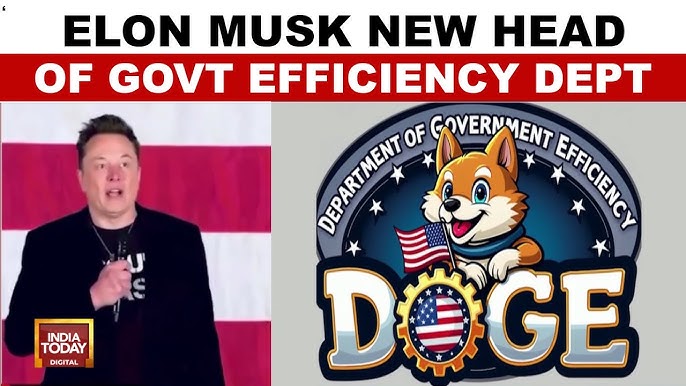Elon Musk, who spent time on the election trail advocating for Donald Trump last October, made a bold statement, asserting his capability to cut government spending by a minimum of $2 trillion. Presently, as he starts to establish his proposed ‘Department of Government Efficiency’ or ‘DOGE’, he seems to be recalibrating his expectations. Musk stated on a Wednesday night, ‘Aiming for a $2 trillion reduction may be the most optimistic scenario. We might have a fair shot at realizing $1 trillion in savings if we keep that goal.’
Following Trump’s victorious run in the elections, the president-elect selected Musk and the renowned business magnate Vivek Ramaswamy to head up DOGE. This non-governmental entity is tasked with proposing methods to reduce federal expenditure. To put it into perspective, federal spending surpassed $6.7 trillion in the last fiscal year alone. Social Security, Medicare, and other health-related costs comprised a considerable portion of the federal budget, alongside interest payments and defense outlay.
Musk’s ambitious $2tn saving goal has garnered applause from allies but drew skepticism as well, particularly considering the persistent opposition from Republican politicians against reducing Social Security and Medicare expenses. The president-elect himself has pledged to steer clear of Social Security cuts. In the same vein, Ramaswamy stated that DOGE won’t target any reductions in these areas but will instead focus on eliminating wastage and fraudulent activities.
Yet Musk gives a more sobering take, suggesting that cost-cutting efforts may paradoxically result in ‘temporary hardship.’ On Wednesday, when queried about specific areas targeted for DOGE’s budget reduction, Musk refrained from pointing at particular sectors. Instead, he generalized that the entire federal government presents a fertile field for cost savings.
Previously, both Musk and Ramaswamy unveiled plans to scrutinize the practice of remote work amongst federal employees, the operations of non-governmental organizations, and evaluate regulations they consider superfluous and obstructive. Their initiative, though novel, has captured the attention of both Republican and Democratic representatives who have conveyed their willingness to support the group’s mandate.
However, the ‘DOGE caucus,’ although still in its formative phase within Congress, remains predominantly under Republican influence. Notably, each politician participating seems to have their specific areas of focus in mind. Representative Rho Khanna of California, a Democrat, and Independent Senator Bernie Sanders from Vermont have both shown interest in targeting defense spending for reductions.
Leading the DOGE Caucus within the Senate, Iowa’s Republican Senator Joni Ernst, proposed cutting funding for electric vehicle charging stations and proposed the sale of ‘thousands’ of underused or vacant buildings owned by the government. These diversified targets indicate the broad, government-wide impact DOGE might have under the leadership of Musk and Ramaswamy.
Even assuming that DOGE’s cost-cutting efforts fall short of meeting Musk’s ambitious $2 trillion target, he believes there’s still room for successful outcome. The tech magnate expressed his belief that such efforts can still significantly contribute to helping Trump carve out a remarkable legacy.
Specifically, he stated, ‘If we can reduce the budget deficit from $2 trillion down to $1 trillion and invigorate the economy with supplemental growth, such that the output of goods and services maintains a steady pace with the increase in the money supply, we can avert inflation.’ His comments underline both his confidence in and commitment to DOGE’s mission, despite the considerable challenges.
In conclusion, Musk’s ambitious goal to reduce federal spending with the DOGE initiative, though met with skepticism and numerous obstacles, carries significant potential for broader fiscal changes. Although the success of his plan remains shrouded in uncertainty, the possibility that it might catalyze a transformation in government spending is, in itself, worthy of consideration.
Regardless of the outcome, Musk’s proposition and the formation of DOGE have ignited a compelling discussion on governmental efficiency and budget optimization. It remains to be seen how Musk, Ramaswamy, and the DOGE Caucus will navigate the convoluted terrain of federal spending, and what impact their efforts will ultimately have.
The road to realizing DOGE’s lofty objectives will undoubtedly be marked with considerable scrutiny and political tug-of-war. Yet, with Musk’s tenacity and ingenuity at the helm, a shakeup to the status quo may just be on the horizon.
Whether DOGE will achieve its targeted cuts, draw a new blueprint for government efficiency, or simply stir the debate on smart spending, the endeavor marks an unprecedented step in the relentless pursuit of governmental efficiency. Its eventual legacy, for good or ill, will undeniably reverberate throughout the echelons of the U.S. federal system.


